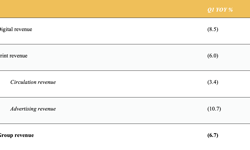An old friend of mine, Barry Henderson, is a veteran in advertising sales. Of course, like me, he will run from the word veteran, mythically thinking as I do that we are still mid-twenties, Adonis, at our physical peak. But in truth, between us we’ve been in this business nearly seventy years.
Barry is passionate about newspaper advertising. And, recently, I encouraged him to write about his views.
He wrote about the importance of creativity. Of sales people being trained in the basics of how advertising works. The need to understand how an advertisement should be constructed: Headline, illustration. The use of white space. Good copy.
And you know what? He was engulfed by comments, emails and phone calls. Why? Because in this newspaper world where everyone is obsessed with the small percentage of revenues generated by digital, there are still old men like Barry and I who believe there is still life in print.
No-one believes in the digital opportunity more than I do. I studied computer science at university, in the early 70s when the computer was a two-storey building. I wrote my first report on the implications of the internet for our industry in 1994. I directed the World Association of Newspapers Shaping the Future of the Newspaper project for five years.
But I despair how newspaper companies seem to have abandoned print, as if they’ve decided it is in the intensive care unit and not worth resuscitation.
The response to Barry’s article reflects what most newspaper managers believe, that we should be continuing to invest in our print products, and not be simply pouring a fortune into digital at print’s expense. After all, and again I am repeating myself, if we don’t invest in promoting our core products, what chance do our new products have of flourishing?
Have you noticed how many digital “pure-plays” are now advertising on main stream media. I even spotted a Google ad on television! This says something interesting.
As I’ve written before, world-wide, digital accounts for 5% of newspaper industry revenues, and in most cases zero percent of industry profits. In five years’ time, it may account for 10%, of revenue but unless there is a radical change in strategy – as seen by companies such as Scandinavian company, Schibsted - digital will still be profit free zone for many. OK, the eReader offers a big cause for optimism but let’s see.
Meanwhile, investment in promotion has been slashed. In the USA and most of Europe, newspaper brands have disappeared. While Coca Cola and Unilever continue to spend about 14% of their turnover on advertising their brands, in the West, newspapers spend less than 1%.
In the advertising department, the notion of regular sales training, in all but a few companies, has been reduced to a token gesture. In the days when I was responsible for advertising departments, the norm was that 10% of time was spent on training and development. Not anymore.
Newspaper companies are becoming more and more complex, with an increase in products, the launch of digital services across different platforms, and the necessary need to identify alternative revenue streams.
All this is good, and the correct structure in both content creation, and revenue generation varies greatly from one company to another.
But the reality is that with this added complexity, we need to be investing more in our employees’ development, not less. At a time when their jobs are becoming more challenging, we are spending less time and money on ensuring they make the most of the opportunities that already exist and are emerging.
As the great response to my friend Barry’s article suggests, there are a lot of people out there who think the same. Oh, to be back in the 70s.










